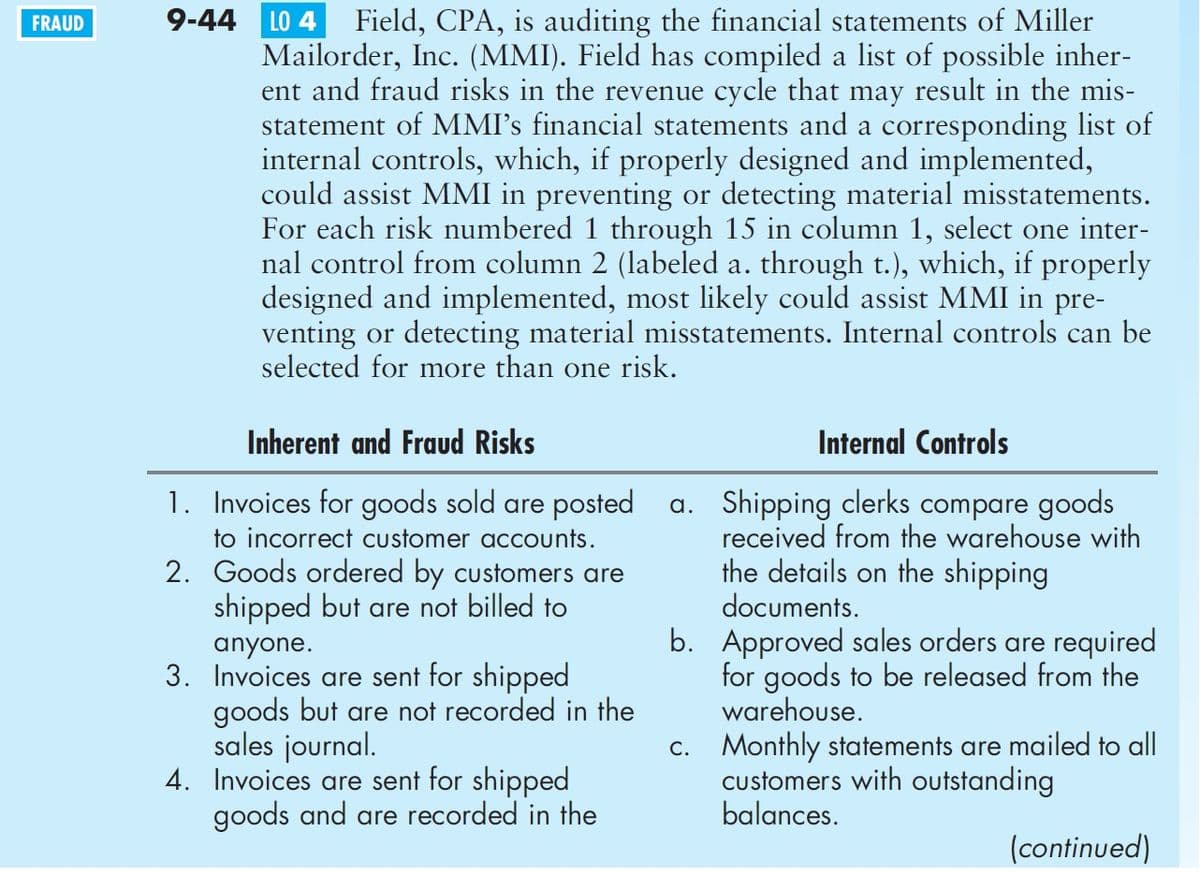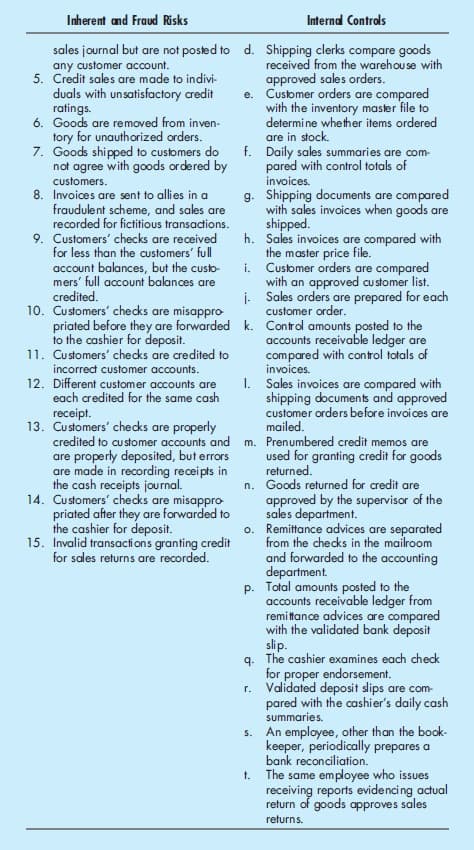Field, CPA, is auditing the financial statements of Miller Mailorder, Inc. (MMI). Field has compiled a list of possible inherent and fraud risks in the revenue cycle that may result in the misstatement of MMI’s financial statements and a corresponding list of internal controls, which, if properly designed and implemented, could assist MMI in preventing or detecting material misstatements. For each risk numbered 1 through 15 in column 1, select one internal control from column 2 (labeled a. through t.), which, if properly designed and implemented, most likely could assist MMI in preventing or detecting material misstatements. Internal controls can be selected for more than one risk
Field, CPA, is auditing the financial statements of Miller Mailorder, Inc. (MMI). Field has compiled a list of possible inherent and fraud risks in the revenue cycle that may result in the misstatement of MMI’s financial statements and a corresponding list of internal controls, which, if properly designed and implemented, could assist MMI in preventing or detecting material misstatements. For each risk numbered 1 through 15 in column 1, select one internal control from column 2 (labeled a. through t.), which, if properly designed and implemented, most likely could assist MMI in preventing or detecting material misstatements. Internal controls can be selected for more than one risk
Auditing: A Risk Based-Approach to Conducting a Quality Audit
10th Edition
ISBN:9781305080577
Author:Karla M Johnstone, Audrey A. Gramling, Larry E. Rittenberg
Publisher:Karla M Johnstone, Audrey A. Gramling, Larry E. Rittenberg
Chapter9: Auditing The Revenue Cycle
Section: Chapter Questions
Problem 76FF
Related questions
Question
100%
Field, CPA, is auditing the financial statements of Miller
Mailorder, Inc. (MMI). Field has compiled a list of possible inherent
and fraud risks in the revenue cycle that may result in the misstatement
of MMI’s financial statements and a corresponding list of
internal controls, which, if properly designed and implemented,
could assist MMI in preventing or detecting material misstatements.
For each risk numbered 1 through 15 in column 1, select one internal
control from column 2 (labeled a. through t.), which, if properly
designed and implemented, most likely could assist MMI in preventing
or detecting material misstatements. Internal controls can be
selected for more than one risk.

Transcribed Image Text:FRAUD
9-44 LO 4
Field, CPA, is auditing the financial statements of Miller
Mailorder, Inc. (MMI). Field has compiled a list of possible inher-
ent and fraud risks in the revenue cycle that may result in the mis-
statement of MMI's financial statements and a corresponding list of
internal controls, which, if properly designed and implemented,
could assist MMI in preventing or detecting material misstatements.
For each risk numbered 1 through 15 in column 1, select one inter-
nal control from column 2 (labeled a. through t.), which, if properly
designed and implemented, most likely could assist MMI in pre-
venting or detecting material misstatements. Internal controls can be
selected for more than one risk.
Inherent and Fraud Risks
Internal Controls
1. Invoices for goods sold are posted
to incorrect customer accounts.
2. Goods ordered by customers are
shipped but are not billed to
a. Shipping clerks compare goods
received from the warehouse with
the details on the shipping
documents.
anyone.
3. Invoices are sent for shipped
goods but are not recorded in the
sales journal.
4. Invoices are sent for shipped
goods and are recorded in the
b. Approved sales orders are required
for goods to be released from the
warehouse.
c. Monthly statements are mailed to all
customers with outstanding
balances.
(continued)

Transcribed Image Text:Inherent and Fraud Risks
Internd Controls
sales journal but are not posted to d. Shipping clerks compare goods
any customer account.
5. Credit sales are made to indivi-
duals with unsatisfactory credit
ratings.
6. Goods are removed from inven-
tory for unauthorized orders.
7. Goods shipped to customers do
not agree with goods ordered by
received from the warehouse with
approved sales orders.
e. Customer orders are compared
with the inventory master file to
determine whether items ordered
are in stock.
f. Daily sales summaries are com-
pared with control totals of
invoices.
g. Shipping documents are compared
with sales invoices when goods are
shipped.
h. Sales invoices are compared with
the master price file.
i. Customer orders are compared
with an approved cu stomer list.
i. Sales orders are prepared for each
customer order.
customers.
8. Invoices are sent to allies in a
fraudulent scheme, and sales are
recorded for fictitious transactions.
9. Customers' checks are received
for less than the customers' full
account balances, but the custo-
mers' full account balances are
credited.
10. Customers' checks are misappro
priated before they are forwarded k. Control amounts posted to the
to the cashier for deposit.
11. Customers' checks are credited to
accounts receivable ledger are
compared with control totals of
invoices.
I. Sales invoices are compared with
shipping documents and approved
customer orders before invoices are
mailed.
incorrect customer accounts.
12. Different customer accounts are
each credited for the same cash
receipt.
13. Customers' checks are properly
credited to customer accounts and m. Prenumbered credit memos are
are properly deposited, but errors
are made in recording receipts in
the cash receipts journal.
14. Customers' checks are misappro
priated after they are forwarded to
the cashier for deposit.
15. Invalid transacthions granting credit
for sales returns are recorded.
used for granting credit for goods
returned.
n. Goods returned for credit are
approved by the supervisor of the
sales department.
o. Remittance advices are separated
from the checks in the mailroom
and forwarded to the accounting
department.
p. Total amounts posted to the
accounts receivable ledger from
remitance advices are compared
with the validated bank deposit
slip.
q. The cashier examines each check
for proper endorsement.
r. Validated deposit slips are com-
pared with the cashier's daily cash
summaries.
s. An employee, other than the book-
keeper, periodically prepares a
bank reconciliation.
t. The same employee who issues
receiving reports evidencing actual
return of goods approves sales
returns.
Expert Solution
This question has been solved!
Explore an expertly crafted, step-by-step solution for a thorough understanding of key concepts.
This is a popular solution!
Trending now
This is a popular solution!
Step by step
Solved in 2 steps

Knowledge Booster
Learn more about
Need a deep-dive on the concept behind this application? Look no further. Learn more about this topic, accounting and related others by exploring similar questions and additional content below.Recommended textbooks for you

Auditing: A Risk Based-Approach to Conducting a Q…
Accounting
ISBN:
9781305080577
Author:
Karla M Johnstone, Audrey A. Gramling, Larry E. Rittenberg
Publisher:
South-Western College Pub

Auditing: A Risk Based-Approach (MindTap Course L…
Accounting
ISBN:
9781337619455
Author:
Karla M Johnstone, Audrey A. Gramling, Larry E. Rittenberg
Publisher:
Cengage Learning


Auditing: A Risk Based-Approach to Conducting a Q…
Accounting
ISBN:
9781305080577
Author:
Karla M Johnstone, Audrey A. Gramling, Larry E. Rittenberg
Publisher:
South-Western College Pub

Auditing: A Risk Based-Approach (MindTap Course L…
Accounting
ISBN:
9781337619455
Author:
Karla M Johnstone, Audrey A. Gramling, Larry E. Rittenberg
Publisher:
Cengage Learning
